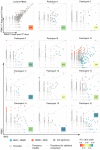This is a preprint.
Spike-specific T cells are enriched in breastmilk following SARS-CoV-2 mRNA vaccination
- PMID: 36203549
- PMCID: PMC9536058
- DOI: 10.1101/2021.12.03.21267036
Spike-specific T cells are enriched in breastmilk following SARS-CoV-2 mRNA vaccination
Update in
-
Spike-specific T cells are enriched in breastmilk following SARS-CoV-2 mRNA vaccination.Mucosal Immunol. 2023 Feb;16(1):39-49. doi: 10.1016/j.mucimm.2023.01.003. Epub 2023 Jan 13. Mucosal Immunol. 2023. PMID: 36642379 Free PMC article.
Abstract
Human breastmilk is rich in T cells; however, their specificity and function are largely unknown. We compared the phenotype, diversity, and antigen specificity of T cells in the breastmilk and peripheral blood of lactating individuals who received SARS-CoV-2 mRNA vaccination. Relative to blood, breastmilk contained higher frequencies of T effector and central memory populations that expressed mucosal-homing markers. T cell receptor (TCR) sequence overlap was limited between blood and breastmilk. Overabundan t breastmilk clones were observed in all individuals, were diverse, and contained CDR3 sequences with known epitope specificity including to SARS-CoV-2 Spike. Spike-specific TCRs were more frequent in breastmilk compared to blood and expanded in breastmilk following a third mRNA vaccine dose. Our observations indicate that the lactating breast contains a distinct T cell population that can be modulated by maternal vaccination with potential implications for infant passive protection.
One-sentence summary: The breastmilk T cell repertoire is distinct and enriched for SARS-CoV-2 Spike-specificity after maternal mRNA vaccination.
Conflict of interest statement
Figures




References
-
- Hassiotou F., Geddes D. T., Hartmann P. E., Cells in human milk: state of the science. J Hum Lact 29, 171–182 (2013). - PubMed
-
- Goldman A. S., Garza C., Nichols B. L., Goldblum R. M., Immunologic factors in human milk during the first year of lactation. J Pediatr 100, 563–567 (1982). - PubMed
-
- Kent J. C., How breastfeeding works. J Midwifery Womens Health 52, 564–570 (2007). - PubMed
Publication types
Grants and funding
LinkOut - more resources
Full Text Sources
Miscellaneous
